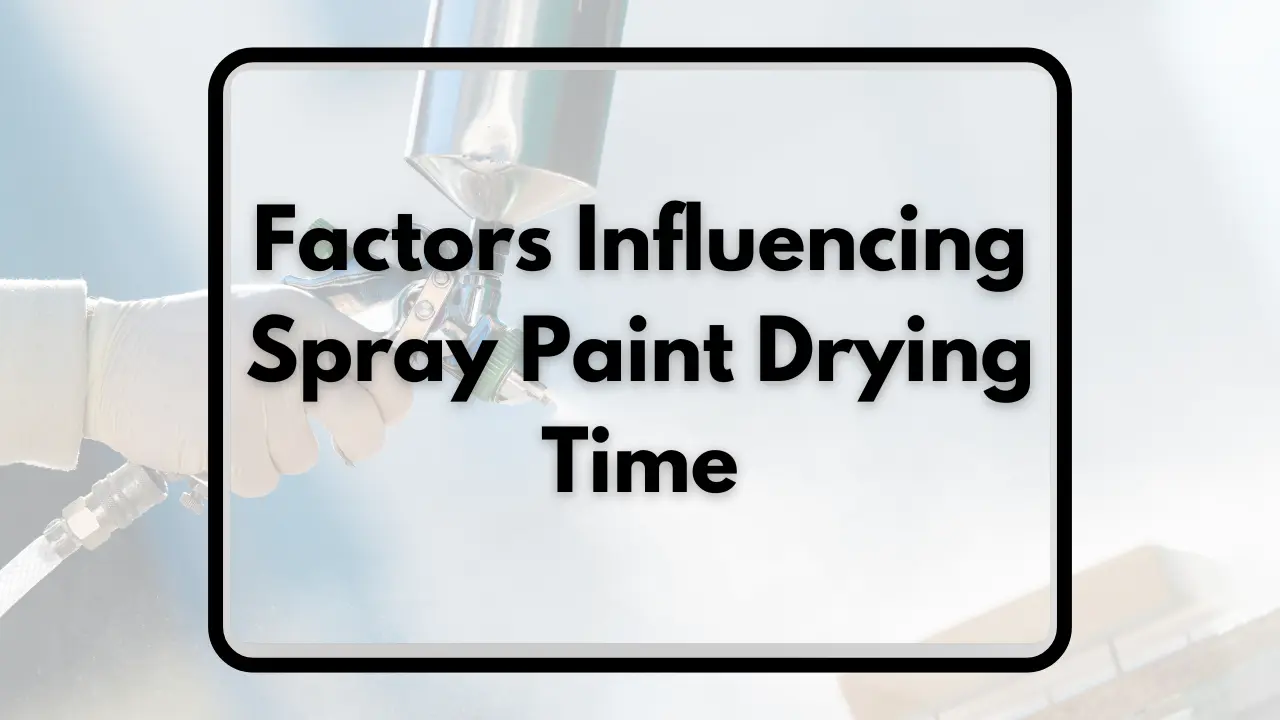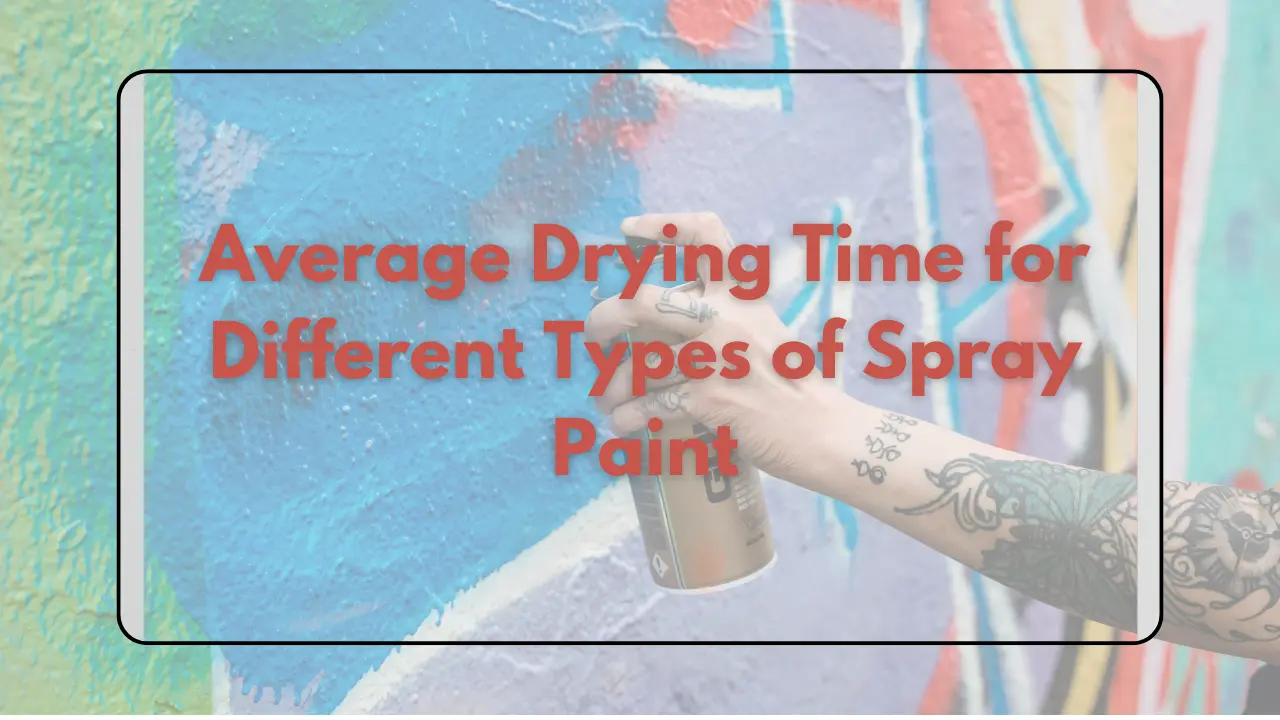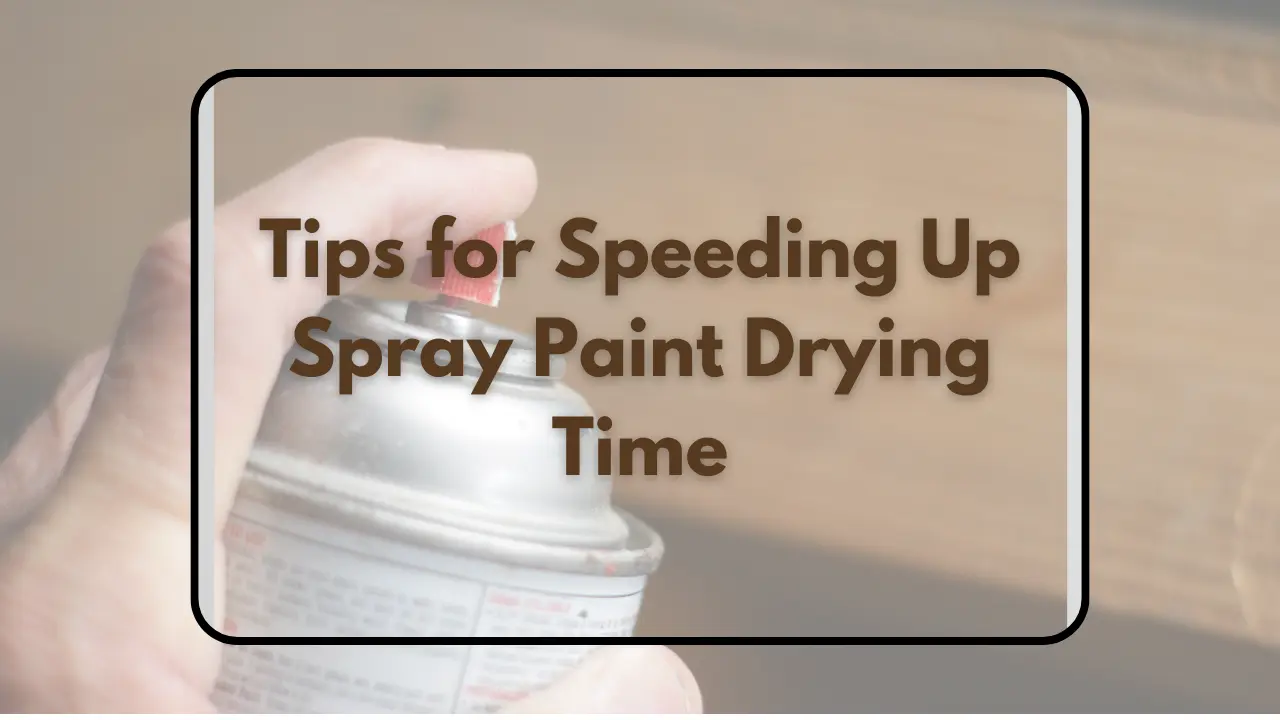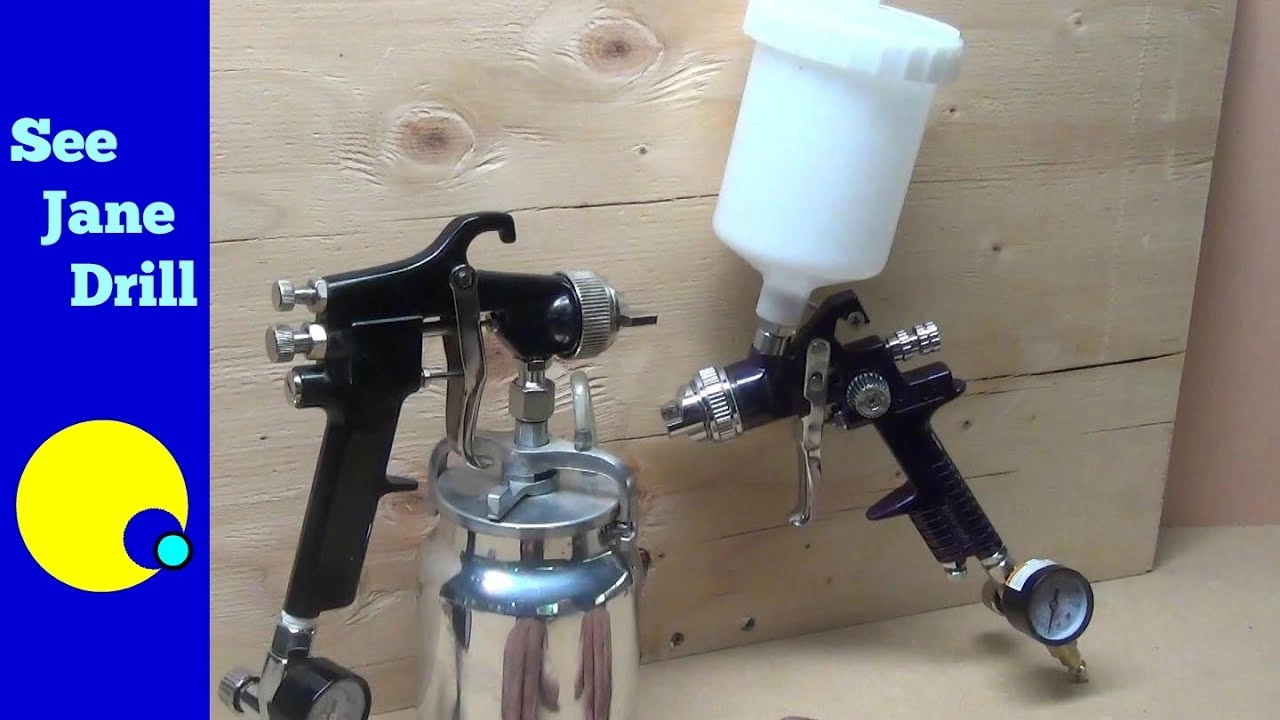How long does spray paint take to dry? Many DIY enthusiasts and home decorators ask it. They ask before starting their projects. You might be sprucing up old furniture or adding a pop of color to your home. Knowing the drying time of spray paint is crucial for getting the best results.
In this guide how long does it take for spray paint to dry, we’ll explore the factors that affect drying time. These factors include the type of paint and the environment. You’ll learn practical tips for speeding up drying. You’ll also learn how to avoid common pitfalls that can ruin your project.
By the end of this article, you’ll know how long spray paint drying time. You’ll also learn the methods to ensure a flawless finish. Are you a seasoned DIYer or a novice? If you’re tackling your first project, this guide will give you the needed knowledge. It will help you achieve pro-quality results every time.
Factors Influencing Spray Paint Drying Time

The article is about spray paint drying duration. This study looks at how temperature and humidity, paint type, and surface shape affect drying. Understanding these factors is crucial. They are key for getting great results in painting projects. This applies to both professional and personal work.
By examining these influences, painters can adapt. They can adjust their techniques and surroundings to speed up drying. Or they can adjust to control drying times. This exploration improves finished products. It also deepens understanding of the science behind spray painting.
Humidity
Humidity affects spray paint drying time, demanding attention for optimal results. In high humidity, moisture saturates paint. This makes drying take longer and invites flaws, like smudges. Low humidity speeds drying but risks premature drying and texture issues.
Monitoring humidity with a hygrometer informs decision-making. It allows adjustments to painting techniques and the environment. Good air flow and controlled temperature and humidity help. Fans or dehumidifiers also help. They reduce humidity’s impact.
Timing painting sessions during periods of lower humidity minimizes complications. Choosing high-quality spray paint with drying enhancers ensures consistency despite humidity variations. Mastery of humidity’s role empowers painters to navigate challenges and achieve professional-grade outcomes.
Temperature
Temperature affects paint application and drying. It also affects the finish’s quality. For optimal results, aim for temperatures between 50°F to 90°F (10°C to 32°C) during painting. In cold weather, paint thickens. It becomes hard to apply. In warm weather, it dries too fast. This leads to uneven coverage.
Consider both the air and surface temperatures before painting. Extremes can harm adhesion and durability. Rapid temperature changes can also make paint film crack or peel. To create ideal painting conditions, keep the temperature moderate. Also, avoid direct sunlight and extreme heat. If needed, regulate the environment with heaters or fans.
Paying attention to temperature helps painters. It ensures smoother application and longer-lasting paint jobs.
Type of Paint
Many factors influence spray paint drying time. They can vary. They include conditions like temperature and humidity. Also, include the type of paint you are using. Yet, the type of paint itself plays a significant role in how it dries.
Here are some common types of spray paint and their general drying times:
1. Acrylic Spray Paint: It dries. This one can be compared to other paints. It dries to the touch within 10-20 minutes. But, full curing may take up to 24 hours or more. This depends on things like how thick it is and the environment.
2. Enamel Spray Paint: It takes longer to dry than acrylic spray paint. It may take 30 minutes to several hours to dry. Complete curing can take 24 hours or more.
3. Lacquer Spray Paint: It dries very, often within minutes. But it may need more time to cure, usually within 24 hours.
4. Oil-based Spray Paint: Oil-based spray paint has a longer drying time than acrylics and lacquers. It may take several hours to dry to the touch, and complete curing can take 24 hours or more.
It’s important to follow the maker’s instructions. These are for drying and curing times. They are specific to the brand and type of spray paint you’re using. Also, factors like temperature, humidity, and ventilation can affect drying times. So, it’s essential to consider these conditions when painting.
Surface Material
The material on which spray paint is applied can also influence drying time. Here’s how different surface materials can affect the drying process:
1. Metal Surfaces: Metal surfaces are often smooth and non-porous. They are good substrates for spray paint. They tend to allow for fast drying times, especially when the metal is clean and free of rust or oil. Yet, temperature and humidity can still affect drying times on metal.
2. Wood Surfaces: Wood is more porous than metal, which can affect drying time. Wood’s absorbency can make spray paint soak in. This can slow drying. Using a primer or sealer can prep the wood. It cuts absorption and speeds drying.
3. Plastic Surfaces: They can vary in their composition. This can impact how well spray paint sticks and dries. Some plastics may need special primers or adhesion promoters. These improve paint adhesion and drying time. Also, some plastics may need longer to dry than other materials.
4. Concrete or Masonry Surfaces: These surfaces are porous. They can also affect spray paint drying time. Like wood, concrete and masonry can absorb paint. This can make drying take longer. Using a primer for porous surfaces helps adhesion. It also reduces drying time.
5. Paper or Cardboard Surfaces: Paper and cardboard surfaces are absorbent. They cause spray paint to dry on contact. But, paper and cardboard are porous. They may need many coats of paint for full coverage and durability.
6. Fabric or Textile Surfaces: You must use special fabric paint to spray paint fabric or textiles. Drying times can vary depending on the type of fabric and the paint used. Fabric paints often need heat-setting to ensure durability and washability.
No matter the surface material, it’s key to prepare the surface. Do this before applying spray paint. This may include cleaning, sanding, and priming. They ensure good adhesion and fast drying. Also, follow the manufacturer’s recommendations for drying and curing times. These times are specific to the type of paint and surface material. They are essential for achieving the best results.
Related Article: How to Stagger Laminate Flooring: Unlock the Secrets
Average Drying Time for Different Types of Spray Paint

Drying times for types of spray paint vary. Several factors determine this. They include the paint type, the environment, and the surface material. Here’s a general guideline for the average spray paint drying duration of common types of spray paint:
- Acrylic Spray Paint: It dries to the touch in 10-20 minutes in ideal conditions. But, curing may take up to 24 hours or more. It depends on factors like thickness and the environment.
- Enamel Spray Paint: It has a longer drying time than acrylics. It may take 30 minutes to several hours to dry. It can take 24 hours or more to cure.
- Lacquer Spray Paint: Lacquer spray paint dries very, often within minutes. But curing may still take 24 hours or more. It depends on the formula and the environment.
- Oil-based Spray Paint: It dries slower than acrylics and lacquers. It may take several hours to dry to the touch, and complete curing can take 24 hours or more.
Drying times are approximate. They can vary based on things like temperature, humidity, and ventilation. Also, on paint thickness and the brand and type of spray paint. You must follow the manufacturer’s instructions for drying and curing times. You must also follow any recommended tips for prep and application. This is key for getting the best results.
Related Article: How Thick Is a Floorboard: Finding the Optimal Thickness for Your Floors
Tips for Speeding Up Spray Paint Drying Time

If you’re eager to see your project completed sooner, there are several tips you can follow to speed up the drying time for spray paint:
- Optimal Conditions: Ensure that you’re spraying in optimal conditions. Choose a day with low humidity and moderate temperature, between 50°F to 90°F (10°C to 32°C). High humidity can make drying take longer. Extreme temperatures can also affect the paint’s ability to dry.
- Ventilation: Adequate ventilation can help drying by promoting air flow and solvent evaporation. Use spray paint in a well-ventilated area. Or use fans or open windows to add airflow.
- Thin Coats: Apply thin, even coats of spray paint rather than thick layers. Thin coats dry more and are less likely to run or drip. Allow each coat to dry completely before applying the next one.
- Distance and Speed: Keep the recommended distance. It is between the spray can and the painted surface. This distance is 6 to 8 inches (15 to 20 centimeters). Move the can at a consistent speed to achieve even coverage. Spraying too close or too can make the application uneven. It can also make it take longer to dry.
- Warm Surface: If you can, warm the surface before spraying paint on it. Warm surfaces can help the paint dry faster. But be careful not to overheat the surface. This is especially important if it’s plastic or sensitive to heat.
- Quick-dry Products: Some spray paints dry faster than others. Look for quick-dry or fast-drying spray paint options at your local hardware store. These products aim to decrease drying time while maintaining quality.
- Use a Hairdryer: If you’re in a hurry, you can use a hairdryer set on a low heat setting to speed up the drying process. Hold the hairdryer several inches from the paint. Move it back and forth to spread the heat.
- Avoid Touching: Avoid touching it. Resist the urge to touch the paint before it’s dry. Touching wet paint can leave fingerprints or smudges and may prolong drying time.
By following these tips, you can help speed up spray paint’s drying time. You can achieve faster results. But, rushing too much can hurt the finish. So, balance speed and precision for the best result.
Related Article: How to Install Anti Slip Stair Treads: Never Slip Again
Common Mistakes to Avoid

Avoiding common mistakes can help ensure that spray paint dries and. Here are some key errors to steer clear of:
- Applying Thick Coats: One of the most common mistakes is applying thick coats of spray paint. Thick layers take longer to dry and are more prone to running, dripping, or wrinkling. Instead, choose thin, even coats. Let each layer dry before adding another.
- Spraying in High Humidity: Painting in high humidity can prolong drying times. Moisture in the air slows solvent evaporation in paint. This leads to tackiness or uneven drying. Check the weather forecast and avoid spraying on rainy or humid days. If necessary, use a dehumidifier or wait for a drier day.
- Ignoring Temperature Guidelines: Extreme temperatures can also affect spray paint drying time. Painting in very cold or hot conditions can lead to improper drying. It can also cause poor adhesion. Stick to the recommended temperature range. It’s on the paint can. It’s for the best results.
- Skipping Surface Preparation: Proper surface preparation is crucial for paint adhesion and drying. Skipping steps like cleaning, sanding, or priming leads to poor adhesion. It also causes longer drying times or even paint failure. Make sure the surface is clean and dry. It must also be free from contaminants before applying spray paint.
- Spraying Too Close or Too Far: Spraying too close or too far is the issue. It affects the finish’s quality and drying time. Spraying too close can cause the paint to pool or run, while spraying too far may result in uneven coverage. Keep the recommended distance, usually 6 to 8 inches, between the spray can and the surface. This distance gives the best results.
- Overloading the Surface: Avoid overloading the surface with paint. This can make it dry longer and cause issues like sagging or dripping. Apply paint in light, even passes, allowing each layer to dry before adding more. Many thin coats are preferable to a single heavy coat.
- Not Allowing Sufficient Drying Time: Rushing the drying process can cause smudges, fingerprints, or damage. Let each coat of paint dry. Follow the manufacturer’s instructions. Then, you can handle or recoat it. Rushing the process can compromise the final finish and durability of the paint.
- Using Improper Paint for the Surface: Not all spray paints are suitable for every surface. Using the wrong type of paint can result in poor adhesion, longer drying times, or even damage to the surface. Make sure to pick a spray paint made for the material you’re painting. This includes metal, wood, plastic, and other surfaces.
Avoid these mistakes. Follow best spray painting practices. You can achieve faster drying and better results.
Related Article: How to Clean Plywood Floors: Effortless Cleaning
Testing Paint Dryness
Testing paint dryness is crucial. It ensures that spray paint has dried enough. Before handling or applying more coats, you must do this. Here are some methods for testing paint dryness:
- Touch Test: Try the touch test. touch a small, hidden area of the painted surface with your fingertip. If the paint feels dry to the touch and doesn’t leave any residue on your finger, it’s likely dry enough to proceed. But, do not press too hard or use too much force. This can leave impressions or damage the paint.
- Visual Inspection: Take a close look at the painted surface under adequate lighting. Look for any signs of wetness, shine, or inconsistency in the paint texture. Dry paint should appear uniform in color and matte in finish, with no areas that appear glossy or wet.
- Tack Test: press a piece of clean, dry tape or masking tape onto the painted surface and then peel it away. If the tape lifts without pulling up any wet paint or leaving residue behind, the paint is likely dry. But, if the tape pulls up paint or leaves a sticky residue, it’s still wet and needs more time to dry.
- Smell Test: Some paints emit strong odors while drying. The odors lessen as the paint cures. If you can still smell a strong paint odor, the paint may still be wet or not cured. But, keep in mind that some paints are low-odor or odorless, so this method may not be suitable for all paints.
- Drying Time Guidelines: Refer to the manufacturer’s instructions on the paint can. They have the recommended drying times. These guidelines can vary. They depend on factors like paint type, temperature, and humidity. But, they give a general time for when the paint should be dry to the touch and ready for recoating.
- Test in an Inconspicuous Area: Test in an unseen spot. If unsure how dry the paint is, test there before touching or adding more coats. This lets you test the paint’s dryness. It avoids risking visible harm to the finish.
Use these methods to test paint dryness. They ensure that spray paint has dried enough. This is before doing more steps, like handling, recoating, or finishing.
Related Article: Rescue Your Floors: How to Remove Paint from Hardwood Floors
FAQs
How long does spray paint take to dry on metal?
The drying time of spray paint on metal can vary depending on factors like humidity and temperature. In general, it may take 24 hours or more for spray paint to dry completely on metal surfaces.
Can I use a hairdryer to speed up the drying process?
While using a hairdryer can help speed up the drying process, it’s essential to use it cautiously to avoid overheating the paint or causing it to bubble. Keep the hairdryer at a moderate distance from the painted surface and use a low heat setting.
What happens if I apply another coat before the first one dries completely?
Applying another coat of paint before the previous one has dried completely can lead to uneven drying, bubbling, or cracking. It’s best to wait until the first coat has dried to the touch before applying additional coats.
Is it safe to handle spray-painted objects before they are completely dry?
Handling spray-painted objects before they are fully dry can result in smudges, fingerprints, or damage to the paint finish. It’s recommended to wait until the paint has dried completely before handling or moving the painted items.
Related Article: Clean Prefinished Hardwood Floors Guide
How long should I wait before applying a clear coat over spray paint?
Wait until the spray paint has dried completely before applying a clear coat to seal and protect the surface. Depending on the type of paint and environmental conditions, this may take 24 hours or more.
Conclusion
In conclusion, spray paint dries at times that vary. This depends on factors like the type of paint, the environment, and the painted surface. Most spray paints dry to the touch within 30 minutes to an hour. But full curing may take up to 24 hours or longer.
Understanding the drying process is key. Taking precautions can ensure the best results for your spray paint projects. Remember to read the manufacturer’s instructions. Set up your workspace. And given enough time for the paint to dry before touching or recoating.
Be patient. Allow the paint time to dry and cure. Then, you can get pro finishes and lasting results in your DIY projects. Now, armed with this knowledge, go ahead and tackle your spray paint projects. You know how long does spray paint take to dry.




